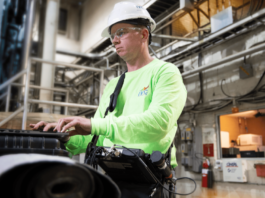In today’s rapidly evolving manufacturing landscape, technological advancements play a pivotal role in driving efficiency, precision, and innovation. Among the various cutting-edge technologies reshaping the industry, fiber laser cutting stands out as a transformative force.
As we delve into the future frontier of fiber laser cutting machines, we uncover the latest innovations and emerging trends shaping its trajectory.
1. Evolution of Fiber Laser Cutting Technology
Fiber laser cutting technology has witnessed significant evolution since its inception. Initially introduced as a novel alternative to traditional cutting methods, such as plasma and waterjet cutting, fiber lasers have undergone continuous refinement.
From enhancements in power output and beam quality to improvements in speed and accuracy, the evolution of fiber laser cutting technology has been marked by relentless innovation.
2. Integration of Artificial Intelligence
One of the most compelling trends in the realm of fiber laser cutting is the integration of artificial intelligence (AI). AI algorithms are increasingly being utilized to optimize cutting parameters, minimize material waste, and enhance process efficiency.
By leveraging machine learning algorithms, fiber laser cutting machines can adapt dynamically to changing conditions, resulting in unprecedented levels of precision and productivity.
3. Industry 4.0 and Digital Connectivity
As manufacturing embraces the principles of Industry 4.0, fiber laser cutting technology is undergoing a paradigm shift towards digital connectivity and smart manufacturing. Advanced sensors embedded within laser cutting systems enable real-time monitoring of performance metrics, predictive maintenance, and remote troubleshooting.
Seamless integration with digital manufacturing platforms facilitates end-to-end workflow automation, empowering manufacturers to achieve greater agility and responsiveness.
4. Multi-Material Processing Capabilities
Traditionally associated with cutting metallic materials, fiber lasers are now expanding their capabilities to encompass a broader range of substrates. From plastics and ceramics to composites and organic materials, fiber laser cutting machine are increasingly versatile in their ability to process diverse materials with precision and efficiency.
This trend opens up new avenues for applications in industries such as aerospace, automotive, and electronics.
5. Ultrafast Laser Cutting
The pursuit of higher cutting speeds and throughput rates has led to the emergence of ultrafast laser cutting technologies. By harnessing pulses of ultra-short duration, ultrafast fiber lasers enable rapid material removal with minimal heat-affected zones and negligible thermal distortion.
This breakthrough not only enhances productivity but also facilitates the processing of heat-sensitive materials, such as polymers and thin foils, with unprecedented precision.
6. Three-Dimensional Laser Cutting
While traditional laser cutting has primarily focused on two-dimensional profiles, the advent of three-dimensional (3D) laser cutting is revolutionizing the manufacturing landscape. By incorporating advanced robotic systems and articulated laser heads, fiber laser cutting machines can navigate complex geometries and contours with unparalleled flexibility.
This capability paves the way for the fabrication of intricate components and assemblies in industries ranging from aerospace to medical devices.
Read also How to Choose the Right Online Loan Service Provider: Factors to Consider
7. Green Laser Technology
In response to growing environmental concerns and sustainability imperatives, the development of green laser technology represents a promising avenue for the future of fiber laser cutting. By leveraging wavelengths that are more readily absorbed by certain materials, green lasers offer enhanced processing capabilities while minimizing energy consumption and environmental impact.
This eco-friendly approach aligns with the growing emphasis on sustainable manufacturing practices across industries.
8. Additive Manufacturing Integration
The convergence of fiber laser cutting with additive manufacturing processes heralds a new era of hybrid manufacturing capabilities. By integrating laser-based powder deposition or wire deposition techniques with subtractive laser cutting, manufacturers can achieve unprecedented levels of design freedom, complexity, and customization.
This synergy between additive and subtractive processes unlocks new possibilities for on-demand production, rapid prototyping, and hybrid part fabrication.
Conclusion
As we navigate the future frontier of fiber laser cutting technology, it is clear that the horizon is brimming with promise and potential. From the integration of artificial intelligence and digital connectivity to the advent of ultrafast and three-dimensional laser cutting, the landscape of possibilities is vast and transformative. By embracing these innovations and emerging trends, manufacturers can unlock new dimensions of efficiency, precision, and creativity in their pursuit of excellence. As the journey continues, one thing remains certain: the future of fiber laser cutting is bright, dynamic, and full of possibilities.



